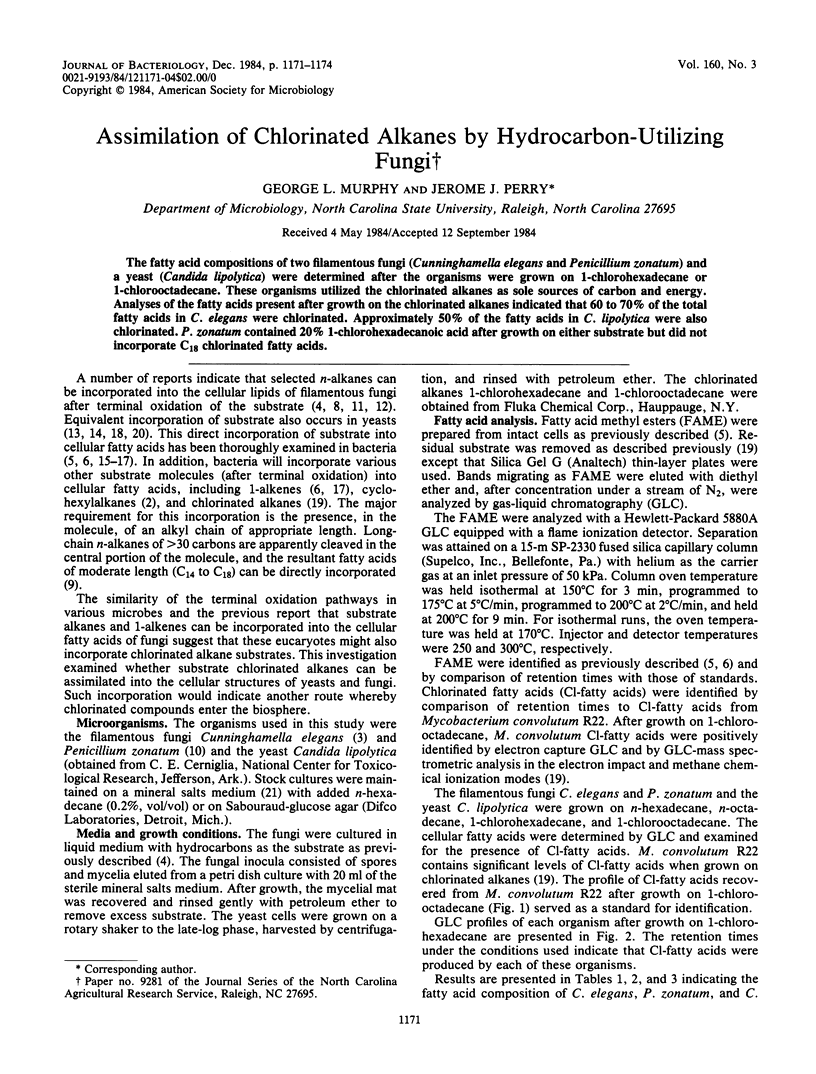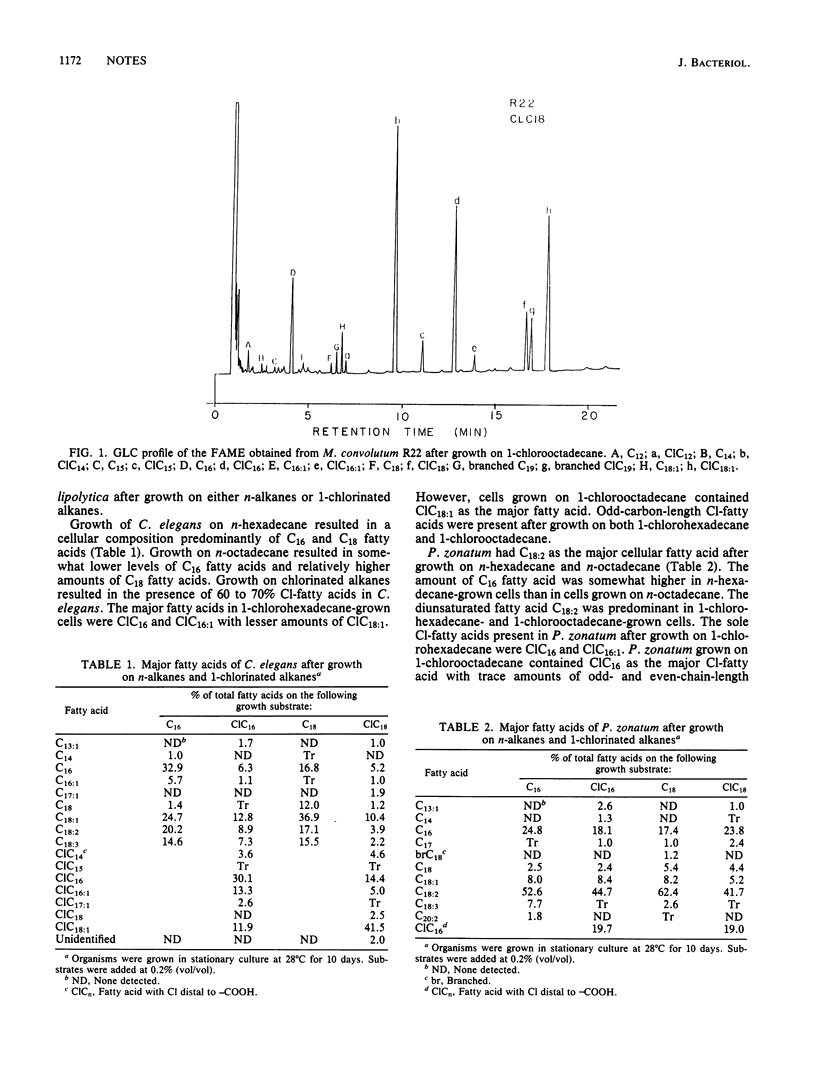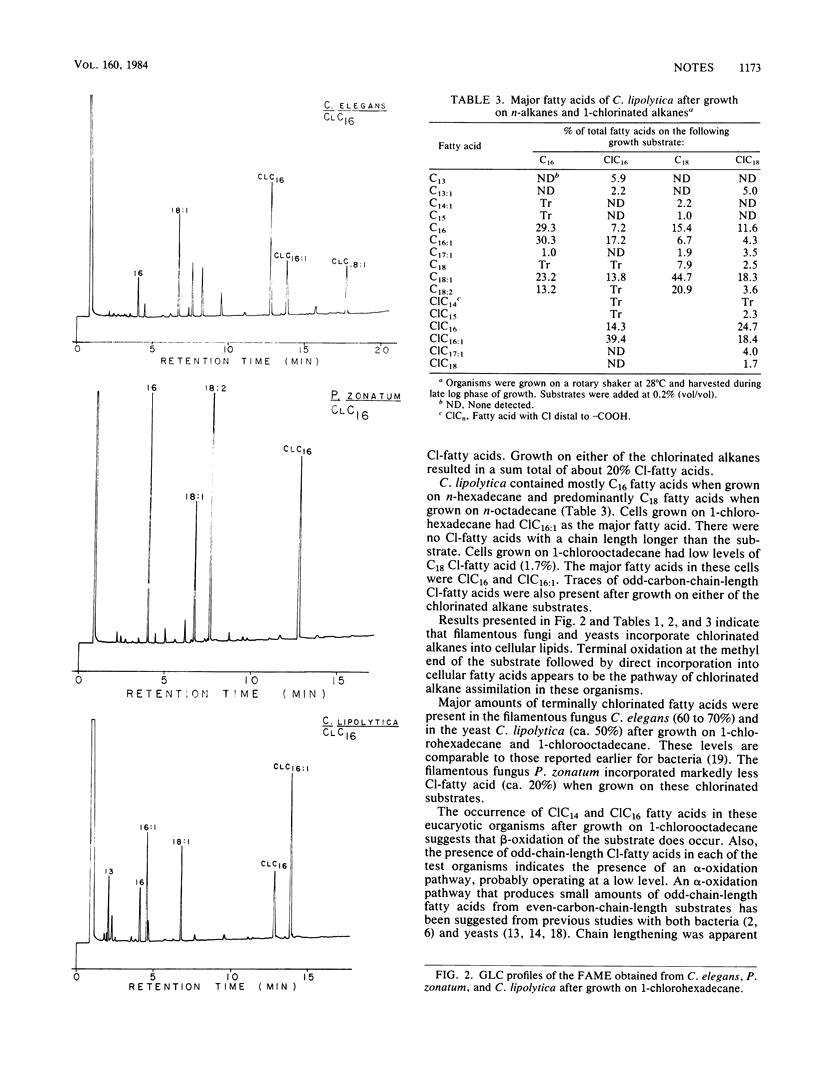Abstract
The fatty acid compositions of two filamentous fungi (Cunninghamella elegans and Penicillium zonatum) and a yeast (Candida lipolytica) were determined after the organisms were grown on 1-chlorohexadecane or 1-chlorooctadecane. These organisms utilized the chlorinated alkanes as sole sources of carbon and energy. Analyses of the fatty acids present after growth on the chlorinated alkanes indicated that 60 to 70% of the total fatty acids in C. elegans were chlorinated. Approximately 50% of the fatty acids in C. lipolytica were also chlorinated. P. zonatum contained 20% 1-chlorohexadecanoic acid after growth on either substrate but did not incorporate C18 chlorinated fatty acids.
Full text
PDF



Selected References
These references are in PubMed. This may not be the complete list of references from this article.
- Baker N., Lynen F. Factors involved in fatty acyl CoA desaturation by fungal microsomes. The relative roles of acyl CoA and phospholipids as substrates. Eur J Biochem. 1971 Mar 11;19(2):200–210. doi: 10.1111/j.1432-1033.1971.tb01305.x. [DOI] [PubMed] [Google Scholar]
- Beam H. W., Perry J. J. Microbial degradation and assimilation of n-alkyl-substituted cycloparaffins. J Bacteriol. 1974 May;118(2):394–399. doi: 10.1128/jb.118.2.394-399.1974. [DOI] [PMC free article] [PubMed] [Google Scholar]
- Cerniglia C. E., Perry J. J. Crude oil degradation by microorganisms isolated from the marine environment. Z Allg Mikrobiol. 1973;13(4):299–306. doi: 10.1002/jobm.3630130403. [DOI] [PubMed] [Google Scholar]
- Cerniglia C. E., Perry J. J. Effect of substrate on the fatty acid composition of hydrocarbon-utilizing filamentous fungi. J Bacteriol. 1974 Jun;118(3):844–847. doi: 10.1128/jb.118.3.844-847.1974. [DOI] [PMC free article] [PubMed] [Google Scholar]
- Dunlap K. R., Perry J. J. Effect of Substrate on the Fatty Acid Composition of Hydrocarbon- and Ketone-utilizing Microorganisms. J Bacteriol. 1968 Aug;96(2):318–321. doi: 10.1128/jb.96.2.318-321.1968. [DOI] [PMC free article] [PubMed] [Google Scholar]
- Dunlap K. R., Perry J. J. Effect of substrate on the fatty acid composition of hydrocabon-utilizing microorganisms. J Bacteriol. 1967 Dec;94(6):1919–1923. doi: 10.1128/jb.94.6.1919-1923.1967. [DOI] [PMC free article] [PubMed] [Google Scholar]
- Ferrante G., Kates M. Pathways for desaturation of oleoyl chains in Candida lipolytica. Can J Biochem Cell Biol. 1983 Nov;61(11):1191–1196. doi: 10.1139/o83-153. [DOI] [PubMed] [Google Scholar]
- Hallas L. E., Vestal J. R. The growth of Mycobacterium convolutum on solid n-alkane substrates: effect on cellular lipid composition. Can J Microbiol. 1978 Oct;24(10):1197–1203. doi: 10.1139/m78-194. [DOI] [PubMed] [Google Scholar]
- Hodges C. S., Jr, Perry J. J. A new species of Eupenicillium from soil. Mycologia. 1973 May-Jun;65(3):697–702. [PubMed] [Google Scholar]
- Hug H., Fiechter A. Assimilation of aliphatic hydrocarbons by Candida tropicalis. II. Fatty acid profiles from cells grown on substrates of different chain length. Arch Mikrobiol. 1973;88(2):87–96. [PubMed] [Google Scholar]
- Iida M., Kobayashi H., Iizuka H. Cellular fatty acids derived from normal alkanes by Candida rugosa. Z Allg Mikrobiol. 1980;20(7):449–457. doi: 10.1002/jobm.3630200704. [DOI] [PubMed] [Google Scholar]
- Imsenecki A. A., Murzakov B. G. Issledovani dekarboksiliruiushchei aktivnosti mikroflory pustynnykh pochv radiometricheskim metodom. Mikrobiologiia. 1975 May-Jun;44(3):408–413. [PubMed] [Google Scholar]
- King D. H., Perry J. J. The origin of fatty acids in the hydrocarbon-utilizing microorganism Mycobacterium vaccae. Can J Microbiol. 1975 Jan;21(1):85–89. doi: 10.1139/m75-012. [DOI] [PubMed] [Google Scholar]
- Makula R., Finnerty W. R. Microbial assimilation of hydrocarbons. I. Fatty acids derived from normal alkanes. J Bacteriol. 1968 Jun;95(6):2102–2107. doi: 10.1128/jb.95.6.2102-2107.1968. [DOI] [PMC free article] [PubMed] [Google Scholar]
- Makula R., Finnerty W. R. Microbial assimilation of hydrocarbons. II. Fatty acids derived from 1-alkenes. J Bacteriol. 1968 Jun;95(6):2108–2111. doi: 10.1128/jb.95.6.2108-2111.1968. [DOI] [PMC free article] [PubMed] [Google Scholar]
- Murphy G. L., Perry J. J. Incorporation of chlorinated alkanes into fatty acids of hydrocarbon-utilizing mycobacteria. J Bacteriol. 1983 Dec;156(3):1158–1164. doi: 10.1128/jb.156.3.1158-1164.1983. [DOI] [PMC free article] [PubMed] [Google Scholar]


